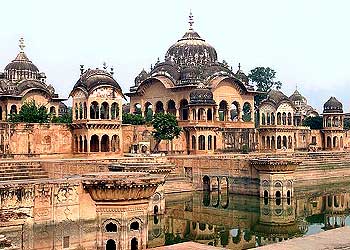Mathura Travel Guide:

Introduction
Mathura is a city in the North Indian state of Uttar Pradesh. It is located approximately 50 km north of Agra, and 145 km south-east of Delhi; about 11 kilometers from the town of Vrindavan and 22 kilometers from Govardhan. It is the administrative centre of Mathura District of Uttar Pradesh. During the ancient period, Mathura was an economic hub, located at the junction of important caravan routes.
Mathura is the birthplace of Lord Krishna at the centre of Braj or Brij-bhoomi, called Shri Krishna Janma-Bhoomi, literally: 'Lord Krishna's birth place'.
The Keshav Dev temple was built in ancient times on the site of Krishna's legendary birthplace (an underground prison). According to the Mahabharata and Bhagavata Purana epics, Mathura was the capital of the Surasena Kingdom, ruled by Kansa the maternal uncle of Krishna.
History
Mathura has an ancient history. According to the Archeological Survey of India plaque at the Mathura Museum, the city is mentioned in the oldest Indian epic, the Ramayana. In the epic, the Ikshwaku prince Shatrughna slays a demon called Lavanasura and claims the land. Afterwards, the place came to be known as Madhuvan as it was thickly wooded, then Madhupura and later Mathura. The demon that Shatrughan killed in Ramayana, Lavanasura was the progeny of a devout king Madhu who gets Lord Shiva's Trident in a boon in the Puranas. The Puranas ascribe the founding of the city to Ayu, the son of Pururavas and the celestial nymph Urvashi. The city might also have got its name from a famous Yadav king Madhu who reigned around 1,600 BC.
In the 6th century BCE Mathura became the capital of the Surasena mahajanapada. The city was later ruled by the Maurya empire (4th to 2nd centuries BC) and the Sunga dynasty (2nd century BC). It may have come under the control of Indo-Greeks some time between 180 BC and 100 BC. It then reverted to local rule before being conquered by the Indo-Scythians during the 1st century BC. Archaeological evidence seems to indicate that, by 100 BC, there was a group of Jains living in Mathura.
Mathuran art and culture reached its zenith under the Kushan dynasty which had Mathura as one of their capitals, the other being Purushapura (Peshawar). The dynasty had kings with the names of Kujula Kadphises, Kanishka, Huvishka and Vasudeva. All the Kushans were patrons of Buddhism except Vasudeo,[citation needed] mentioned on coins as Bazodeo. Kanishka even hosted the third Buddhist council, the first two being hosted by Ajatshatru and Ashoka the Great. The headless statue of Kanishka is in the Mathura Museum.
Megasthenes, writing in the early 3rd century BC, mentions Mathura as a great city under the name ?????a (Méthora).
Geography
Mathura is located at 27.28°N 77.41°E.[16] It has an average elevation of 174 metres (570)
Demographics
As of 2001 India census, Mathura had a population of 298,827. Males constitute 53% of the population and females 47%. Mathura has an average literacy rate of 75%, higher than the national average of 59.5%: male literacy is 74%, and female literacy is 76%. In Mathura, 15% of the population is under 6 years of age.
Strategic importance
Mathura is the home for Indian I Corps (Strike Formation) within the Indian Army's Central Command, hosting Strike I Corps headquarters in a large classified area in the outskirts of the city known as Mathura Cantonment (Central Command itself has its headquarters at Lucknow). It hosts Strike Infantry units, Air Defence units, Armoured Divisions, Engineer brigades, Aritillery Units and classified units of Strategic Nuclear Command. Corps I is primarily responsible for western borders of India. In 2007 during Exercise Ashwamedha, all the armoured, artillery and infantry divisions performed a simulation of an overall NBC (nuclear-chemical-biological) environment. The aim was to show operational ability in high intensity, short duration and 'sudden' battles.
Industries
oday Mathura is situated on very important Road and Train routes in India. The famous Delhi-Agra highway (NH-2, National Highway -2) runs close to Mathura, providing the city with great connectivity. The city also houses a large and important train station; Mathura Junction. The city is on both the Delhi-Mumbai and Delhi-Chennai train routes.
One of the major contributors in the economy of Uttar Pradesh are Mathura Industries. Mathura Refinery located in the city is one of the biggest oil refineries of Asia. This oil refinery of the Indian Oil Corporation is a highly technologically advanced oil refinery. Silver polishing industry is another industry that is flourishing gradually. Textile printing industry that includes both Sari-printing and Fabric dyeing is another major industry of the region. Apart from these other industries are water tap manufacturing units and other decorative and household items